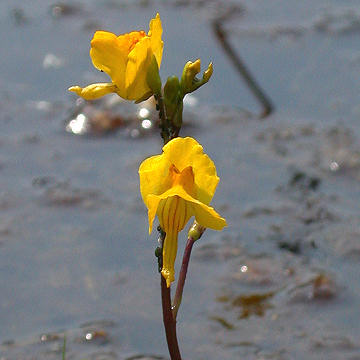

Utricularia vulgaris - (image 1 of 5)
Taxonomy
Family: Lentibulariaceae
Habitat
Shallow, quiet water.
Associates
Distribution
Circumboreal, south to FL and CA. Typical U. vulgaris occurs in Europe, while ssp. macrorhiza is found in both North America and Asia.
Morphology
Submersed, free floating aquatic herb. Stems loosely floating beneath the surface of the water. Leaves numerous, alternate, 1-5 cm, unequally dichotomously dissected, the segments terete and progressively narrowed, the ultimate ones filiform and acuminate; bladders numerous, on the leaves, the larger ones more than 2 mm across. Flowers yellow, mostly 6-20 in lax, emergent racemes; peduncles 6-20 cm long, with one to several bracts below the inflorescence; corolla bilabiate; lower corolla lip little if any longer than the upper, mostly 1-2 cm, slightly lobed, with a well developed palate; spur falcate, directed forward, about 2/3 as long as the lower lip.
Notes
Flowers June to September
Wetland indicator: Obligate
The tiny bladders on the leaves are used to trap aquatic animals. When touched, small hairs near the opening of the bladder trigger a rapid inflow of water, sucking the prey into the trap.
References
Gleason, Henry A. and A. Cronquist. 1991. Manual of Vascular Plants of Northeastern United States and Adjacent Canada. Second Ed.
The New York Botanical Garden. Bronx, NY
Swink, F. and G. Wilhelm. 1994. Plants of the Chicago Region.
Indiana Academy of Science. The Morton Arboretum. Lisle, Illinois.
|
Michael Hough © 2009 |